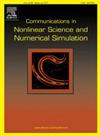Nonlinear high-dimensional flutter analyses of variable stiffness porous sandwich conical shells
IF 3.4
2区 数学
Q1 MATHEMATICS, APPLIED
Communications in Nonlinear Science and Numerical Simulation
Pub Date : 2025-04-03
DOI:10.1016/j.cnsns.2025.108826
引用次数: 0
Abstract
In this work, the nonlinear flutter characteristics of the truncated porous sandwich conical shell with variable stiffness under simply supported boundary, which is placed in the thermal environment and supersonic flow, are explored. The sandwich variable stiffness conical shell is constructed of two carbon fiber surface sheets and a porous core with aluminum foam, which has the exponential variable thickness along the longitudinal direction and five various styles of porosity distribution schemes along the thickness direction. The supersonic aerodynamic pressure is presented by utilizing the first-order piston theory considering the curvature effect. By means of the first-order shear deformation theory (FSDT), Hamilton's principle and Galerkin technique, the high-dimensional nonlinear variable stiffness second-order ordinary differential equations of motion are derived. The critical flutter points can be determined and flutter boundaries can be examined by addressing the linear eigenvalue problem. By applying the fourth-order Runge-Kutta approach, the influences of the exponent of thickness function, porosity distribution pattern, porosity coefficient, semi-vertex angle, temperature increment, total number of layers, fiber orientation angle, the core layer's minimum radius-thickness ratio and length-thickness ratio, on nonlinear flutter behaviors are analyzed in depth. The results reveal that the porous varying thickness sandwich conical shell with Style-O distribution and 0° fiber orientation angle is a better choice for high stability against flutter, and linear flutter analysis can be chosen to explore the flutter boundary by further comparison.
求助全文
约1分钟内获得全文
求助全文
来源期刊

Communications in Nonlinear Science and Numerical Simulation
MATHEMATICS, APPLIED-MATHEMATICS, INTERDISCIPLINARY APPLICATIONS
CiteScore
6.80
自引率
7.70%
发文量
378
审稿时长
78 days
期刊介绍:
The journal publishes original research findings on experimental observation, mathematical modeling, theoretical analysis and numerical simulation, for more accurate description, better prediction or novel application, of nonlinear phenomena in science and engineering. It offers a venue for researchers to make rapid exchange of ideas and techniques in nonlinear science and complexity.
The submission of manuscripts with cross-disciplinary approaches in nonlinear science and complexity is particularly encouraged.
Topics of interest:
Nonlinear differential or delay equations, Lie group analysis and asymptotic methods, Discontinuous systems, Fractals, Fractional calculus and dynamics, Nonlinear effects in quantum mechanics, Nonlinear stochastic processes, Experimental nonlinear science, Time-series and signal analysis, Computational methods and simulations in nonlinear science and engineering, Control of dynamical systems, Synchronization, Lyapunov analysis, High-dimensional chaos and turbulence, Chaos in Hamiltonian systems, Integrable systems and solitons, Collective behavior in many-body systems, Biological physics and networks, Nonlinear mechanical systems, Complex systems and complexity.
No length limitation for contributions is set, but only concisely written manuscripts are published. Brief papers are published on the basis of Rapid Communications. Discussions of previously published papers are welcome.
 求助内容:
求助内容: 应助结果提醒方式:
应助结果提醒方式:


